The last session of Positions in flux: On the changing role of the artist and institution in the networked society (see previous posts) discussed the impact of the open source culture on art production and its presentation.
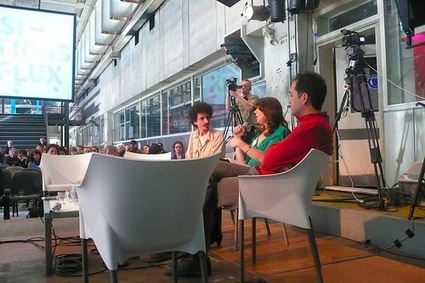 Jaromil and Marcos Garcia discussing with moderator Josephine Bosma
Jaromil and Marcos Garcia discussing with moderator Josephine Bosma
The open source movement is driven by the idea of collective, process-based, sustainable production and improvement. In software development this strategy has already proven to be valid; however can this model be applied to other products such as artworks or even exhibitions? In how far does the open source model differ from other forms of artistic collaboration? Is there a new role model for both the artist and the curator in the future? Which (economic) value and impact has expertise in open source production? How could institutions and organisations respond to this trend? How could institutions and organisations respond to this trend and create public domains?
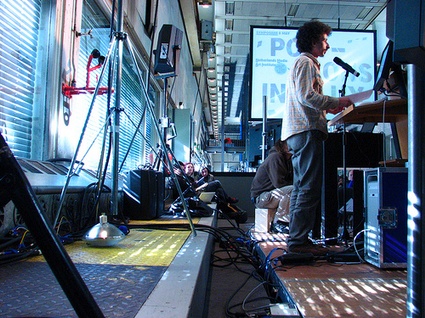 Jaromil. Photo Nimk
Jaromil. Photo Nimk
Jaromil made my blogger’s jpb a piece of cake. I was planning to write down the notes i took during his presentation but, hey! look! he did it all himself and i recommend the lecture. Jaromil gave the lowdown on free software and open source, the way they are (mis)perceived, their strengths/weaknesses and the new challenges ahead.
Denis ‘Jaromil’ Roio is the main author of the GNU/Linux Live CD Dyne:bolic as well as of a number of audiovisual tools. He is also an artist who has exhibited internationally. Based in Amsterdam, Jaromil is active on open source R&D in art and multimedia for the NIMK, adjunct lecturer (year 2008) for the Media Design MA at PZwart / WDKA in Rotterdam and the Digital Environment Design MA at NABA in Milan.
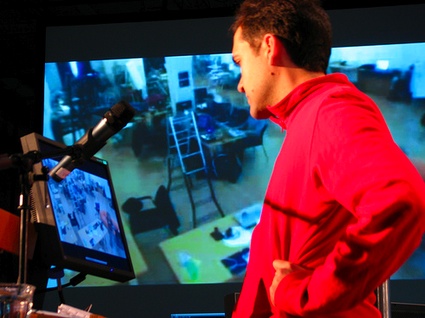 Marcos Garcia. Photo Nimk
Marcos Garcia. Photo Nimk
Hop! Next speaker was Marco Garcia from MediaLab Prado in Madrid. Now most of you have probably heard of the fantastic workshops and talks (btw, have a look at the videos of some of the latest talks: Susanne Jaschko’s talk about Fluid Architectures, a round table with Anab Jain, Yashas Shetty (if you have to see just one, fast forward to his talk, it’s fantastic), and Sunil Sudhakaran. Plus, if you speak spanish, there’s Marta Peirano’s presentation of her book El rival de Prometeo (The Rival of Prometeus) and a talk by architect Andrés Jaque) they organize.
Medialab Prado’s activities focus on themes such as interactivity, data visualization, the Commons and network culture theory and audio-visual and sound creation.
Marcos started his presentation by mentioning how important Christopher Kelty‘s book Two Bits: The Cultural Significance of Free Software has been important in the shaping of what Medialab Madrid is today. He referred particularly to Kelty’s notion of ‘recursive publics’–social configurations that realize the Internet’s non-hierarchical, ever-evolving, and thus historically attuned logic, creatively updating the types of public spheres previously theorized by Habermas and Michael Warner, among others.
One of the most interesting issues raised was “Should we change old institutions to make them more in tune with the OS mouvement or should we create new ones?”
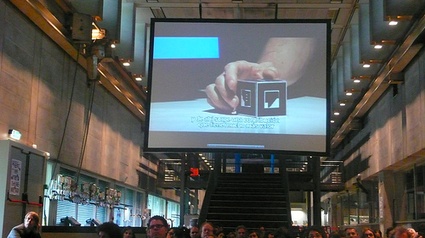
Marcos exemplified the spirit of Medialab Prado by detailing Interactivos? This series of production-oriented workshops that question the notion of interactivity and combine production, learning and exhibition in 15 days. There has already been 20 interactivos workshops all over the world (Mexico, New York, Lima, Salamanca, etc.) Artists/designers/creators selected for the workshop come with their project and Medialab Prado helps them realize it. The production is open right from the beginning. The workshop goes beyond the tools (Arduino, Pure Data, Processing, etc.) and make the technology and the whole building process accessible to people who are only beginners. The fact that participants come from so many different backgrounds and culture (Medialab Prado’s workshop are held in english and open to people from all over the world) means that there is a unique environment, each one comes with their own way of solving a problem. Workshops are accompanied by group discussions, expert presentations, open debates and each project is documented online.
Joasia Krysa, founder of KURATOR, has a particular interest in an emerging discourse and practice that links curating with software and networks. Some of her most recent curatorial projects include openKURATOR, an open submission and presentation platform developed by KURATOR. She is the editor of Curating Immateriality (Autonomedia, New York 2006) and lecturer/researcher at the AZTEC (Art Science Technology Consortium at the University of Plymouth.
Krysa explained that if curating can be conceptualised as a system with its own underlying code and sets of protocols then OS curating would imply an open access to those protocols. It would also suggest a possibility of development through a collective process. A few exemples of such curating include C@C Computer Aided Curating, 1993 – 1995, Runme.org in 2003, unDEAF in 2007 and softwareKURATOR (v1) in 2009.
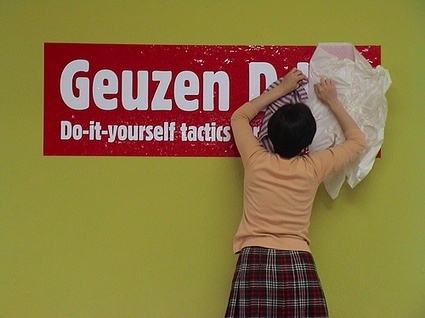
The last speakers were Femke Snelting and Renée Turner from De Geuzen, a foundation for multi-visual research and the collaborative identity. Since 1996 they explore female identity, narratives of the archive and media image ecologies. Exhibitions, workshops and online projects operate as thematic framing devices where the group investigates and tests ideas collectively with different publics. Characterising what they do as research, their work is open-ended, values processes of exchange and promotes critical interrogation. To be honest at that stage i stopped taking notes, i just sat on my chair and enjoyed their presentation.
Some of the projects they discussed: DIY paper dresses, Female Icon Impersonators and a series of works around the ideas of person of Guy Debord.
Image on the homepage: Positions in Flux symposium by Olga Westrate.
